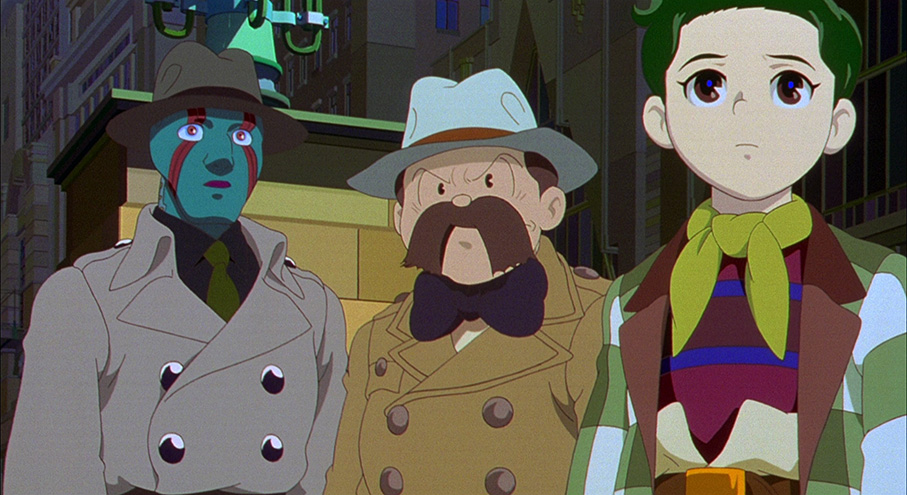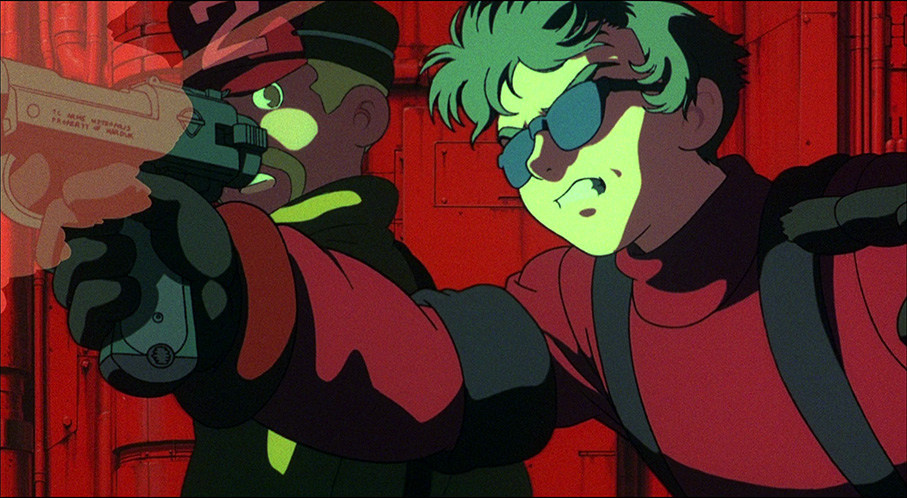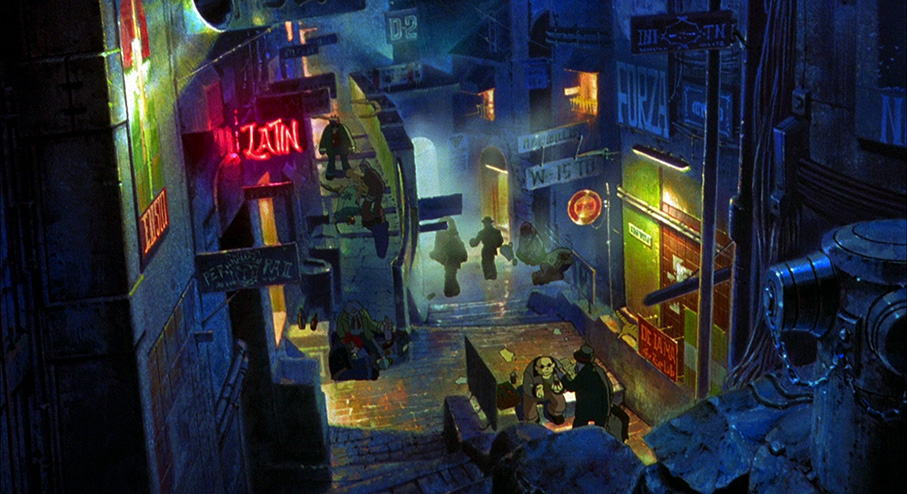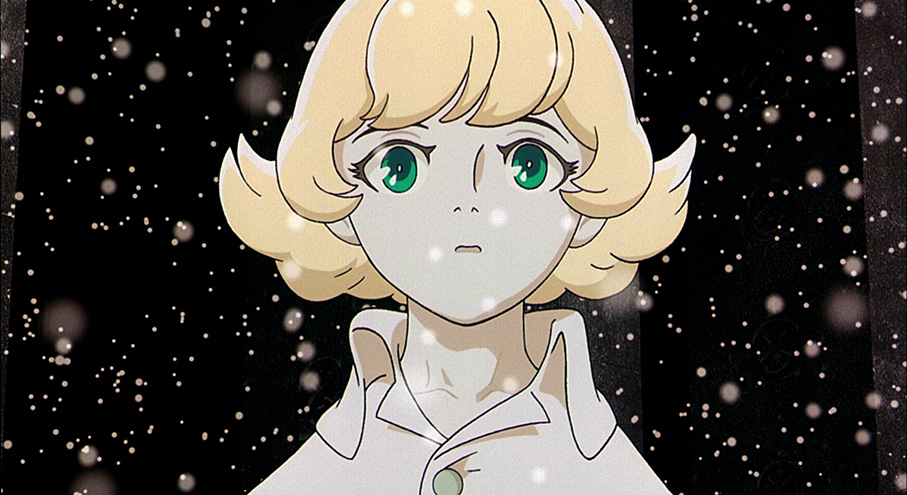|
When I first caught wind of the 2001 anime feature, Metropolis, I made the assumption – as I've no doubt many did – that it was basically an animated remake of Fritz Lang's 1927 science fiction masterpiece of the same name. The poster, however, seemed to cast some doubt on this, featuring as it did the sort of innocent-looking, saucer-eyed child so beloved of Japanese animation. Not the Robot Maria of the original, then. Only later did I learn that the film was based on a 1949 manga by Astro Boy creator, Tezuka Osamu, a work that drew clear inspiration from Lang's original but which did not attempt to retell its story. From what I can gather, the makers of this belated film adaptation were as creative with their source material as Tezuka was with his.
In the futuristic city of Metropolis, robots coexist with humans but remain a tightly regulated underclass who are the subject of discrimination by everyone from the wealthy elite to former manual workers who blame the machines for taking their jobs. Although holding no official office, the most powerful and popular man in the city is the obscenely wealthy Duke Red, who has just overseen the construction of a giant skyscraper known as the Ziggurat. As the building's opening celebrations get under way, Japanese private detective Ban Shunsaku and his nephew Kenichi arrive in the city to track down and arrest Dr. Laughton, a mad but brilliant scientist who is wanted on several warrants for organ trafficking. What Shunsaku doesn't know is that Laughton is in the employ of Duke Red, who has hired him to build a robot in his late daughter Tima's image. Red's head of security and unofficially adopted son Rock, however, has no intention of letting an artificial life form steal his father's heart, and on discovering where Laughton is secretly holed up, shoots him and sets his laboratory ablaze.

Making enquiries nearby and alerted to the fire, Shunsaka and Kenichi arrive on the scene to find unemployed workers talking rebellion after one of them identifies the fleeing Rock as a member of the Malduk Party. The Malduks are a former vigilante group who have been tasked with calming anti-robot sentiment, but who now spend their time hunting down and terminating malfunctioning robots or those who have strayed outside of their designated sector. When Shunsaka learns that Laughton was a regular visitor to the now burning building, he and Kenichi attempt to make their way inside, but while Shunsaka finds the dying Laughton and retrieves his notebook, Kenichi discovers the prematurely awakened Tima, and tumbles with her down to the city's lowest level. As Shunsaka and the robot detective assigned to him go in search of Kenichi, Rock realises that Tima was not destroyed in the fire as planned and gives chase with the intention of terminating her, unaware that she was also designed to be the final component in a machine that will transform the Ziggurat into a terrifying weapon and set Duke Red on the path to world domination.
Although always fluid in execution, Metropolis is a fascinating blend of styles and influences. The social inequality and unrest of Lang's original has been spiced up here by transforming the target of revolutionary ire from an uncaring bourgeoisie into a supervillain with a devilish plan to conquer the world, while Lang's Robot Maria, who was programmed from the start to replace her human counterpart, here becomes a cradle of new-born innocence who hungrily absorbs the teachings of the first human with whom she has contact. And while many of the characters fit the anime template, a small number feel almost as if they've wandered in from lands afar – Shunsaka has the look and countenance of an associate of Hergé's Tintin, while Duke Red's diminutive, vulture-nosed scientist could almost have been a contestant in Wacky Races. This stylistic mix extends to the eye-catching melding of traditional cell animation with computer-generated 3D imagery (a technique that would be further developed by Oshii Mamoru three years later in his mesmerising Ghost in the Shell 2: Innocence), and a traditional orchestral score by Honda Toshiyuki that is regularly punctuated by lively explosions of New Orleans jazz.

That most of the key characters are drawn either as young teens or character-actor elders is not unusual for anime, but may prove a little disconcerting for western viewers not familiar with the conventions of the genre. This is particularly true of Rock, who murders with impunity and a complete lack of conscience but who has the appearance of a kid who's not long hit puberty and whose stated mission is to shoot and kill a girl that's even younger than him, albeit one to which science and engineering has given birth. The moral discomfort this prompts is heightened by Tima's blank-slate innocence and initial unawareness of her robot status, something she later struggles to come to terms with in a manner the prefigures current explorations of this quandary in shows such as Humans and Westworld.
The anthropomorphising of robots of all shapes and sizes is also a favourite anime trait (when assigned a robot detective, the first thing Shunsake and Kenichi do is give him a name) and reaches a cute-critical moment here when Kenichi names a helpful and smiley-faced service robot 'Fifi', and we're already talking about a machine with the model name of Albert II. But even this works for the film on a subtextual level, helping to humanise the discrimination that the robots suffer at the hands of the human population, something that has inescapable parallels with current anti-immigration rhetoric, and the very real fear of the impact that rising levels of automation will have on jobs. It also contributes to the film's touching finale, and casts a different light on the scene in which the first test of the Ziggurat's power causes robots stationed on the planet's surface to malfunction, which the Malduks respond to by furiously gunning them down.
Metropolis looks gorgeous, from its epic cityscapes to the underground industrial constructs to which the lower level robots are confined. The animation is of a similarly high standard, being smoothly executed and peppered with the sort of small character details for which Japan's top animation directors are justly celebrated. Most important of all, it tells a rattling good story, one whose busy and thoughtfully constructed storyline (screenwriter Ôtomo Katsuhiro wrote and directed the breakthrough anime feature Akira) takes a few unexpectedly dark turns and builds to a spectacular climax with surrealistic overtones, as urban destruction on an epic scale unfolds to the romantic strains of Ray Charles and I Can't Stop Loving You. All the right buttons are then pressed for an end-of-main-story emotional response – I certainly fought back a sentimental tear, but still had a beaming smile on my face as the credits rolled.
There are only so many boxes to tick on an HD transfer of an animated feature for it to qualify for a big thumbs-up and Metropolis hits them all. The image is clean, the detail precise, the colours bright (at least when they're designed to be), the contrast well balanced and there's no obvious trace of digital artefacts or banding. In short, it looks great here. The framing is the original 1.85:1.

You can choose between the original Japanese audio track and the expected English dub, both of which are available either in Linear PCM stereo or DTS-HD Master Audio 5.1 surround. The stereo tracks are solid enough, but the DTS surround tracks wipe the floor with them, having a far livelier dynamic range, punchier bass and more precise clarity on the sound effects and music, both of which sound terrific on this track. The explosive effects of destruction are far superior on the DTS track, and the use of the full sound stage makes for a far more inclusive audio experience. As ever, I preferred the performances and the matching of voices to character on the original Japanese track (this was, after all, the one that Rintaro directed), but the English dub is actually pretty good and some of the voice work here is commendable. For once, you won't be seriously short-changed if you opt for the English language track, but I'd still go for the Japanese original if you can.
Three optional English subtitle tracks are available: the original English translation of the Japanese audio track; the translation that accompanied the American release of the Japanese language version; and subtitles of the English language track for the deaf and hearing impaired. As ever, the dialogue on the English language track has been altered (or should that be localised?) from the Japanese original, although the thrust of conversations is generally the same. In common with (too) many American dubs of Japanese animated features, dialogue has often been added or expanded in an attempt to busy-up the soundtrack further. It would take a patient person to start listing the differences between the original translation and the one done for the US theatrical release, but again this is down to the finer detail and the choice of words.
The Making of Tezuka Osamu's Metropolis (33:16)
A very Japanese promotional documentary, complete with enthusiastic narration and ever-present background music, framed widescreen but sitting in a 4:3 frame, which sees the image windowboxed on all four sides. It's driven along primarily by interviews with cast and crew members, who recall how the project came to be and talk about the blending of traditional cel animation with computer-generated imagery, the use of New Orleans jazz tracks on the soundtrack, the strengths of Japanese animation, performing the characters, and more. There's a "what, seriously?" moment when screenwriter Otomo reveals that the character of Rock – who is not in the original manga – got his name "because I like rock music," and when asked what if he thinks original manga author Tezuka Osamu would have liked the film, Otomo replies laughingly, "We couldn't possibly have done it if Tezuka-san was still alive. I think he would have hated it," then adds after a brief pause, "maybe."

Filmmaker Interviews (8:03)
Brief interviews with director Rintaro and writer Otomo, shot at the same time as their contributions to the promotional featurette. Similar ground is covered here – how the project began, the mix of cel and computer animation, what Tezaku would probably think of the film – but in a little more detail. The most amusing comment also acts as a spoiler so I can't tell you about it.
Animation Comparisons
Two short sequences – City View (0:41) and Wheel Room (0:55) – that you can use the pop-up menu on your remote control to view at different stages of their development whilst playing.
Trailer (1:41)
"The most spectacular anime in motion picture history" is the bold claim made by the narrator of this American trailer for the Japanese language version, which also carries a couple of very positive quote from director James Cameron. SD quality, and what's with the music here?
Promotional Trailer (2:17)
Extracts from the film set to an unrelated techno track.
A thoroughly enjoyable, handsomely executed and thematically layered anime that draws inspiration from a number of works of science fiction film and literature (and yes, Blade Runner is one of them), yet melds them into a very satisfying whole. A strong presentation and a small handful of decent extras make Eureka's dual format release easy to recommend.
The Japanese convention of surname first has been used for Japanese names throughout this review.
|